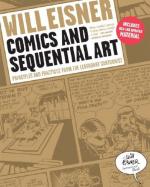
|
| Name: _________________________ | Period: ___________________ |
This test consists of 5 short answer questions, 10 short essay questions, and 1 (of 3) essay topics.
Short Answer Questions
1. What has primacy over text in comics?
2. What kind of movements are "frozen" in time?
3. What typically develops before graphic development?
4. What do the writer and artist "pledge allegiance" to when working on comics together?
5. What other method requires production of a paperboard with colors added to transparent overlays?
Short Essay Questions
1. How has technology challenged the individuality of artists?
2. How can posture and gesture give insight into a character's lifestyle and allow sociological observations?
3. Why does Eisner reproduce the story written by Jules Feiffer that was never published?
4. Name four of the eleven points Eisner covers, because he thinks an artist must understand about how objects work in order to portray them skillfully.
5. Why do entertainment comics deny to the readers/viewers much of the freedom they would enjoy in pure prose?
6. How can the artist successfully convey an image of the human body?
7. Why are comic book artists frequently hired to produce storyboards for movie scripts and motion pictures?
8. How are comic book artists most challenged in portraying amorphics?
9. Give a brief synopsis of Chapter 5.
10. What temptation do artists have to detract from the text?
Essay Topics
Write an essay for ONE of the following topics:
Essay Topic 1
In Chapter 6, Eisner discusses the history of repetitive glyphs and explains their importance in comics as a form of language. Compare and contrast the repetitive glyphs in early cave drawings, Egyptian friezes, hieroglyphics, and comics. How did these codes progress? How did comics draw upon and progress from these ancient examples?
Essay Topic 2
Chapter 4 specifies the technical aspects of perspective, communication, and interpretation. The contrast between visceral and intellectual is discussed in reference to the audience's interpretation of meaning. Explain why Eisner considers bridging the gaps in action between panels more of a visceral than intellectual activity. Cite two examples from Chapter 4 in your answer.
Essay Topic 3
in Chapter 2, calligraphy is described as an expression of visual symbols that also carry verbal and aural traits. Using three instances of supporting evidence from Chapter 2, explain the visual, verbal, and aural characteristics of calligraphy.
|
This section contains 817 words (approx. 3 pages at 300 words per page) |

|




